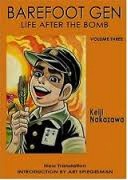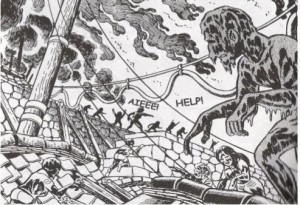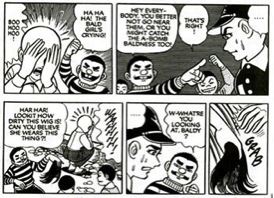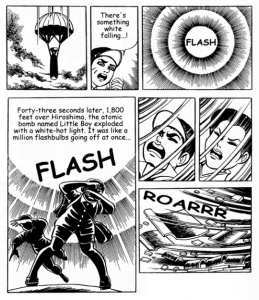Welcome to Using Graphic Novels in Education, an ongoing feature from CBLDF that is designed to allay confusion around the content of banned books and to help parents and teachers raise readers. In this column, we examine books that have been targeted by censors and provide teaching and discussion suggestions for the use of such books in classrooms.
This month, we take a closer look at Barefoot Gen by Keiji Nakazawa, translated by Project Gen (Last Gasp of San Francisco, 2004). Barefoot Gen is considered one of the most important anti-war manga ever written. The series focuses on the atomic bombing of Hiroshima and the aftermath of the Pacific War. This past August, Barefoot Gen was banned in Matsue City, Japan. CBLDF contributor, Dan Kanemitsu, translator and Japanese culture expert, has followed this story. While the controversy is briefly related below, please visit Dan’s blog, and recent CBLDF posts for more details.
The Concerns
In August, Barefoot Gen was removed from Matsue City school libraries because it was considered an “ultra-leftist manga that perpetuated lies and instilled defeatist ideology in the minds of young Japanese.” Education, Culture, Sports, Science and Technology Minister Hakubun Shimomura supported the decision, explaining that the manga was “harmful to youth” with its depictions of violence and chaos in Japan in the 1940-50’s. After tremendous outcry, the Barefoot Gen ban has been overturned.
There is violence in this work: Parents and teachers hit their children to bring them into line, characters fight and bite each other to resolve conflicts, and the horrors of the war are clearly depicted. And while it requires maturity from its readers due to brief nudity and violence, readers leave with a message of the urgency of compassion and civic responsibility and the strength of hope.
The Merits
Barefoot Gen is an important work and classroom addition. First, it relays an informed accounting of Japan’s role in World War II and is a strong anti-war piece that cannot and should not be silenced. Second, Nakazawa relates a strong geopolitical perspective of the war, discussing the power of political machines, “divine rule” versus democracy, and the power individual citizens must exercise to secure their rights and uphold their values. Finally, this work provides a window for understanding and comparing Eastern and Western cultures — where they meet, where they clash, and what we can and cannot assume.
Table of Contents
SERIES SUMMARY
Barefoot Gen’s ten volumes are based upon Nakazawa’s first-hand experiences of life in war-torn Hiroshima. In his “Note from the Author,” Nakazawa writes:
The atomic bomb exploded 600 meters above my hometown of Hiroshima on August 6, 1945 at 8:15 a.m. I was a little over a kilometer away from the epicenter, standing at the back gate of Kanzaki Primary School, when I was hit by a terrible blast of wind and searing heat. I was six years old. I owe my life to the school’s concrete wall…I found myself in a living hell, the details of which remain etched in my brain as if it happened yesterday…
Volume One: A Cartoon Story of Hiroshima begins in Hiroshima, early August 1945. It establishes the main characters and relays the causes and horrors of the war. We meet Gen, his family friends, and neighbors, and through their interactions, we learn the Emperor’s rationale for war. We also witness the blind support most Japanese showed and their cruel attempts to silence alternate political and social opinions.
Gen’s father, Daikichi is critical of the war and labeled a traitor by their community. His children beaten and shunned by peers and teachers, Daikichi is jailed and tortured, and merchants refuse to sell them the limited resources and food available. A short time later, the atomic bomb is dropped, and we see the nightmarish hell it brought. Victims’ flesh is burned and hanging from their bodies, others are trapped under homes or running from fires, many are maimed and/or dying. The remainder of Volume One reveals how Gen and others find the means and the courage to deal with the pain and shame of surviving.
Volume One opens with Gen and his family trampling wheat with their father who tells them:
“Wheat pushes its shoots up through the winter frost, only to be stepped on again and again. The trampled wheat sends strong roots into the earth, endures frost, wind and snow, grows straight and tall…and one day bears fruit.”
It is this metaphor/advice, which recurs throughout all ten volumes, that gives Gen the strength and will to survive.
The remaining volumes relate life in the aftermath of the war through the eyes of Gen, his family, orphaned friends, and other survivors whose paths cross Gen’s:
- Volume Two: The Day After
- Volume Three: Life After the Bomb
- Volume Four: Out of the Ashes
- Volume Five: The Never-ending War
- Volume Six: Writing the Truth
- Volume Seven: Bones into Dust
- Volume Eight: Merchants of Death
- Volume Nine: Breaking Through Borders
- Volume Ten: Never Give Up
Barefoot Gen offers a historical testament, a strong anti-war message, a geopolitical explanation of the 1940s and 1950s and the Pacific War, as well as a look at cultural differences and ethical issues that we as individuals must always keep in mind.
HISTORICAL/POLITICAL FACTORS
Over the course of the ten volumes, Nakazawa details the bomb’s aftermath from a humanistic, cultural, and political perspective:
- We learn why Japan went to war and how China and Korea were stripped of their natural and human resources, including the enslavement of those captured.
- We see that while most Japanese blindly supported the Emperor’s “divine right” and rule, a growing number of people began to question and resist it.
- We learn the immediate effects of the bomb: the melting and/or burning of survivors’ skin, destroyed and collapsed buildings (often trapping the occupants), raging fires, and radiation poisoning.
- We learn the long term effects of the bomb: limited/contaminated food and water, homelessness, orphans, radiation poisoning and medical/health issues that doctors were unequipped to handle, rampant crime, misuse and abuse of drugs and medications, and the crumbling of law and order.
- We witness Japanese social and political reactions after the bombs:
- Burned, sick, and disfigured survivors were ostracized.
- Writing about the atomic bomb was forbidden for many years.
- The “Peace Preservation Law” empowered police to round up those who opposed the war or complained about the government.
- The Hiroshima Peace Memorial City plan empowered police to demolish homes for roads with no recompense for the displaced.
- We learn about the Atomic Bomb Casualty Committee (ABCC), an American agency that studied the effects of the bomb from corpses and from survivors who agreed to testing (but who were rarely treated).
- We learn about the different political parties (Labor versus the Blood Iron Party), and the National Police Reserve (renamed Japan Self-Defense Forces), which was used as a strong military arm to keep citizens in check.
- We also learn the rationale and politics of the Korean War, and why America’s role in the war threatened Japan.
CULTURAL DIFFERENCES
Over the course of the series, several cultural differences between Western and Japanese perspectives are evident:
- Writing styles:
- Japanese are lengthier storytellers, they more easily accept use of violence, manga drawing style is different from Western comics, and there is an interspersion of prose, poetry, and song.
- In Volume Seven, Nakazawa tells the Hiroshima story in a different voice — that of an established writer (as opposed to Gen’s voice from ages 6-15), allowing readers to compare an additional text source and writing style.
- Western democracy versus the Emperor’s “right of divine rule”
- The cultural roles that prayer and superstition play:
- Burial rituals and beliefs (cremation versus burial)
- The hiring of professional prayers
- Violence and its role in Japanese life at home, in schools, and on the streets.
THEMES FOUND THROUGHT THE SERIES
- Survival: finding food and shelter, deciding whom to trust and befriend
- Courage: what it meant to different characters and how they found it in different ways and places
- Varying uses, means, and acceptance of violence on local, national, and international levels
- The rights and consequences of citizens speaking out against wrongs by others and local and high-ranking government officials
- Propaganda and rhetoric used to rally citizens and promote war or any government-sponsored program
- Local and national government policies towards refugees, orphans, and devastation
- Ways and means of dealing with disaster.
TEACHING AND DISCUSSION SUGGESTIONS
Cultural Diversity, Civic Responsibilities, and Social Issues
- Compare and contrast the Japanese “right of divine rule” versus the Western republics, looking at individual rights and state responsibilities.
- Discuss Japanese propaganda used on local and national levels and how it was used to create and sustain support for the war.
- Compare and contrast Japanese rhetoric and propaganda to that of Germany and that of the United States used in World War II. Discuss how they are similar and different, analyzing what makes them successful.
- Volume Two, p. 174-5: Gen says “The government tries to get us to fight their wars by telling us the Americans, Koreans and Chinese are weak and stupid. Don’t be fooled by their lies!”
- Have students create “anti-propaganda tools” they can use to become more critical of rhetoric.
- Discuss how the Japanese treated the Koreans and Chinese.
- Discuss how the Japanese treated their burned, ill, and disfigured family members.
- Discuss how people use faith, and prayer when dealing with natural and man-made disasters in their efforts to explain them and/or find comfort.
- In Volume Four, Ryuta tells Gen and his mother that if they pray to Buddha, they’ll find their baby. Gen responds: “That’s just a superstition…”
- Gen’s mother reacts to the atomic bomb devastation asking, “Why are the fates so cruel to us? Where is God? Were is the Buddha?”
- Debate the pros and cons of using atomic or nuclear weapons. You may want to re-enact debates President Truman might have had and/or debate current policy towards nuclear weapons and strategies for nuclear proliferation in countries like Iran or North Korea.
- Create a class project on civic responsibility. Chose a local, state, or national issue with which students might want to become involved.
- Compare and contrast cultural uses and tolerance of violence.
Language, Literature, and Language Usage
- Compare and contrast how courage and bereavement are expressed by various characters (Gen, his parents, Ryuta, Mr., Seiji, Nat sue, etc.)
- Search for, define, and discuss the book’s use of idioms, metaphors, and similes. For example:
- Volume One, p. 1: Nakazawa opens with a metaphor how trampled wheat sends strong roots into the earth and endures adversity to grow straight, tall and bear fruit.
- Volume Six, p. 148: Gen and his friends, angry at victims’ ostracism note “Japanese people are so cruel. The pot can’t call the kettle black. No one’s any different. We’re all in the same boat. We fight and put each other down without thinking about who the real enemies are.”
- Volume Seven, pp. 56-75: Mr. Matsukichi’s shares his account of the bomb: “The Enola Gay released a single atomic bomb over the center of Hiroshima, delivering tickets to hell to every one of the 400,000 people who lived there. The tickets were scattered in an enormous white-hot flash that sent out a 5,000-degree heat wave… a devilish pathogen that pursues its assault on the human body without end.”
- Compare and contrast Mr. Matsukichi’s language and prose when describing the effects of the bomb (Volume Seven, pp. 56-75) to Gen’s. Analyze how the writer’s voices and how their languages choices effect the overall story.
Modes of Storytelling and Visual Literacy
- Discuss Nakazawa’s use of the rising/setting sun and of wheat throughout the ten volumes. Chart when he uses them, discuss what they symbolize, and how they help the story.
- Discuss how images, shading, and background changes are used by Mr. Nakazawa to help emphasize a particular point. For example:
- Volume One, p. 48: After Gen’s family is shunned as traitors, we see Gen’s mother with the three smaller kids in a spotlight against a black background. His mother says, “No matter how often you’re stepped on, grow up tall and strong, through the wind and snow…” Discuss why the background has changed from white to black and Nakazawa’s use of the spotlight.
- Volume Two, p. 215: After being severely mistreated, Nakazawa narrates, “Once again, Gen learned how cruel the world can be and how hard it is to survive.” Accompanying the text is an image Gen, back facing us. We see his crying reflection in a puddle of water, surrounded by dead leaves. This is the only instance we see a character’s reflection. Ask students to explain why.
- Volume Four, p. 20: The first time we see U.S. soldiers’ faces, their helmets cast shadows over their eyes, so they look like they’re wearing eye masks. Discuss the impact and intention of this image.
- Volume Ten, p. 203: We see a grieving father, sitting on a mat with an open window and brisk wind blowing leaves in and out of the room, remorseful for how he treated his daughter. Discuss the imagery: the blowing leaves, the open window, and the bowing bereft father.
Suggested Prose Novels and Related Films
- So Far From the Bamboo Grove by Yoko Kawashima Watkins, a semi-autobiographical memoir depicting the struggles of Yoko and her family (Japanese citizens) as they flee their home in Naman, North Korea, at the outbreak of World War II.
- Hiroshima: A Novella by Laurence Yep (fiction), in short chapters and simple prose, tells the story of Hiroshima, switching from crewmen on the Enola Gay to children in a Hiroshima classroom. He describes the attack, its destruction and aftermath, and explains the physics of the explosion and the effects of radiation.
- The Gadget by Paul Zindel (fiction), about 13-year-old Stephen Orr, who lives with his father on a military base in Los Alamos. His father is a leading physicist working on the atomic bomb. Stephen and his friend devise a plan to discover the true nature of “the gadget” his dad is working on.
- Bomb: The Race to Build – and Steal – the World’s Most Dangerous Weapon by Steve Sheinkin (non-fiction), chronicling the race between the United States and the Soviets to capture German scientists and their respective race to build the atomic bomb.
- Barefoot Gen – the film by Geneon Entertainment, 2006
- Hiroshima: Why the Bomb was Dropped, ABC News, a documentary examining the rationale behind the decision to use the atomic bomb against Japan. Originally produced as an ABC News special program in 1996.
- White Light, Black Rain: The Destruction of Hiroshima and Nagasaki, an HBO documentary film by Steven Okazaki. Viewable on YouTube (note that parts are quite graphic).
COMMON CORE STATE STANDARDS (CCSS)
Barefoot Gen can be used in high school language arts and history/social studies classes. It is full of rich language, literary devices and imagery, while documenting a very troubling chapter in modern history. It raises issues of conscience, religion, ethics, civic responsibilities, and cultural biases and differences. This series, when coupled with the teaching suggestions above, addresses a wide range of Common Core State Standards, including:
- Key ideas and details: Citing strong and thorough textual evidence to support analysis of what the text says explicitly as well as inferences drawn from the text; citing specific textual evidence to support analysis of primary and secondary sources; determining where the text leaves matters uncertain; determining themes or central ideas of a text and analyzing in detail its development over the course of the text, including how it emerges and is shaped and refined by specific details; analyzing in detail a series of events described in a text, determining whether earlier events caused later ones ore simply preceded them; providing an objective summary of the text; analyzing how complex characters develop, interact with other characters, and advance the plot or develop the theme; analyzing the impact of the author’s choices regarding how to develop and relate elements of a story.
- CCSS.ELA-Literacy.RL.9-10.1
- CCSS.ELA-Literacy.RL.9-10.2
- CCSS.ELA-Literacy.RL.9-10.3
- CCSS.ELA-Literacy.RL.11-12.1
- CCSS.ELA-Literacy.RL.11-12.2
- CCSS.ELA-Literacy.RL.11-12.3
- CCSS.ELA-Literacy.RI.9-10.1
- CCSS.ELA-Literacy.RI.9-10.2
- CCSS.ELA-Literacy.RI.9-10.3
- CCSS.ELA-Literacy.RI.11-12.1
- CCSS.ELA-Literacy.RI.11-12.2
- CCSS.ELA-Literacy.RI.11-12.3
- CCSS.ELA-Literacy.RH.9-10.1
- CCSS.ELA-Literacy.RH.9-10.2
- CCSS.ELA-Literacy.RH.9-10.3
- Craft and structure: Determining the meaning of words and phrases, including figurative, connotative, and technical meaning, and vocabulary describing political, social, or economic aspects of history/social science; analyzing how an author’s choices about structuring a text, ordering events within it, and manipulating time create such effects as mystery, tension, or surprise; analyzing the impact of specific world choices on meaning and tone including words with multiple meanings or language that is particularly fresh, engaging or beautiful; determining an author’s point of view or purpose in a text in which the rhetoric is particularly effective, analyzing how style and content contribute to the power, persuasiveness or beauty of the text; analyzing a particular point of view or cultural experience reflected in a work of literature outside the United States; comparing points of view of two or more authors for how they treat the same or similar topics;
- CCSS.ELA-Literacy.RL.9-10.4
- CCSS.ELA-Literacy.RL.9-10.5
- CCSS.ELA-Literacy.RL.9-10.6
- CCSS.ELA-Literacy.RL.11-12.4
- CCSS.ELA-Literacy.RL.11-12.5
- CCSS.ELA-Literacy.RL.11-12.6
- CCSS.ELA-Literacy.RI.9-10.4
- CCSS.ELA-Literacy.RI.9-10.5
- CCSS.ELA-Literacy.RI.9-10.6
- CCSS.ELA-Literacy.RI.11-12.4
- CCSS.ELA-Literacy.RI.11-12.5
- CCSS.ELA-Literacy.RI.11-12.6
- CCSS.ELA-Literacy.RH.9-10.4
- CCSS.ELA-Literacy.RH.9-10.5
- CCSS.ELA-Literacy.RH.9-10.6
- Integration of knowledge and ideas: Analyzing how an author draws on and transforms source material in a specific work; comparing and contrasting texts; distinguishing among fact, opinion, and reasoned judgment in a text; analyzing multiple interpretations and/or various accounts of a story, drama, poem, subject, evaluating how each version interprets [it]; delineating and evaluating the argument and specific claims in a text, addressing whether the reasoning is valid and the evidence is relevant and sufficient, identifying false statements and fallacious reasoning.
- Range of reading and level of text complexity: By the end of the year, read and comprehend literature, including stories, dramas, and poems, in the grades 9-12 text complexity band proficiently, with scaffolding as needed at the high end of the range.
- Knowledge of language: Using knowledge of language to understand how language functions in different contexts, to make effective choices for meaning or style and to comprehend more fully when reading or listening.
- Vocabulary acquisition and use: Determining the meaning of unknown and multiple-meaning words and phrases; demonstrating understanding of figurative language, word relationships, and nuances in world meanings; and acquiring and using accurately grade-appropriate general academic and domain-specific words and phrases.
- Research to build and present knowledge: Drawing evidence from literary or informational texts to support analysis, reflection, and research.
- Comprehension and collaboration: Engaging effectively in a range of collaborative discussions building on others’ ideas and expressing their own clearly.
- Presentation of knowledge and ideas: Presenting claims and findings, sequencing ideas logically and using pertinent descriptions, facts, and details to accentuate main ideas or themes.
This book and related discussions also cover the following themes identified by The National Council for the Social Studies:
- Culture and Cultural Diversity: “…analyze and explain how groups, societies and cultures address human needs and concerns… predict how experiences may be interpreted by people from diverse cultural perspectives and frames of references …to comprehend multiple perspectives …analyze the ways that a people’s cultural ideas and actions influence its members…”
- Time, Continuity, and Change: “…apply concepts such as time, chronology, causality, change, conflict and complexity to explain/analyze patterns of historical change and continuity … investigate, interpret, and analyze multiple historical and contemporary viewpoints within and across cultures related to important events, recurring dilemmas, and persistent issues, while employing empathy, skepticism, and critical judgment…”
- Individual Development and Identity: “…describe how family, religion, gender, ethnicity, nationality, socioeconomic status, and other group/ cultural influences contribute to the development of a sense of self…analyze the interactions among ethical, national, and cultural factors in specific situations… compare/evaluate the impact of stereotyping, conformity, acts of altruism, discrimination, and other behaviors on individuals and groups…”
- Individuals, Groups, and Institutions: “… understand the concepts of role, status, and social class and use them in describing the connections and interactions of individuals, groups, and institutions in society… analyze groups and evaluate the influence of institutions, people, events, and cultures in both historical and contemporary settings… identify and analyze examples of tensions between expressions of individuality and efforts of groups and institutions to promote social conformity… examine belief systems basic to specific traditions and laws in contemporary and historical societies…”
- Power, Authority, and Governance: “…understand the purpose of government and how its powers are acquired, used and justified… examine issues involving rights, roles and status of individuals in relation to the general welfare… explain conditions, actions and motivations that contribute to conflict and cooperation within and among nations… analyze and explain governmental mechanisms to meet needs of citizens, regulate territory, manage conflict and establish order and security… apply concepts such as power, role, status, justice, and influence to the examination of persistent issues and social problems…”
- Global Connections: “…explain conditions and motivations that contribute to conflict, cooperation, and interdependence among groups, societies and nations… analyze the relationships and tensions between nations and global interests in such matters as territorial disputes, economic development, nuclear and other weapons deployment, use of natural resources and human rights concerns…”
- Civic Ideals and Practices: “…understand the origins and continuing influence of key ideals of the democratic republican form of government, such as individual human dignity, liberty, justice, equality, and the rule of law… analyze and evaluate the influence of various forms of citizen action on public policy… evaluate the effectiveness of public opinion in influencing and shaping public policy development and decision-making…”
ADDITIONAL RESOURCES
- Kid’s Peace Station (Hiroshima)
- Hiroshima Peace Site: Hiroshima Peace Memorial Museum Website
- Atomic Bomb Museum
- Asia for Educators: The Atomic Bomb
- Asia for Educators: The Decision to Use the Bomb
- Asia for Educators: Lesson plans
- Primary Sources: World War II and the Bomb
- Lesson plan: Victory in the Pacific, 1943-45
- Teaching History.org: The Atomic Bomb – Hiroshima and Nagasaki
- Lesson Plans (Atomic Heritage) : The Birth of the Atomic Bomb
- Lesson Plans: Race to build the atomic bomb
- Lesson Plans: Children of the atomic bomb: A UCLA Physician’s Report and Call to Save the World’s Children by Esther Tiara
- Lesson Plan: Debating the Bomb (Getty Museum)
- Slide show on the attack on Pearl Harbor (History Place)
In closing, I’d like to leave you with a quote from Albert Einstein:
“I do not know how the Third World War will be fought, but I can tell you what they will use in the Fourth…rocks!”
Meryl Jaffe, PhD teaches visual literacy and critical reading at Johns Hopkins University Center for Talented Youth OnLine Division and is the author of Raising a Reader! and Using Content-Area Graphic Texts for Learning. She used to encourage the “classics” to the exclusion comics, but with her kids’ intervention, Meryl has become an avid graphic novel fan. She now incorporates them in her work, believing that the educational process must reflect the imagination and intellectual flexibility it hopes to nurture. In this monthly feature, Meryl and CBLDF hope to empower educators and encourage an ongoing dialogue promoting kids’ right to read while utilizing the rich educational opportunities graphic novels have to offer. Please continue the dialogue with your own comments, teaching, reading, or discussion ideas at meryl.jaffe@cbldf.org and please visit Dr. Jaffe at http://www.departingthe text.blogspot.com.
All images (c) Keiji Nakazawa





